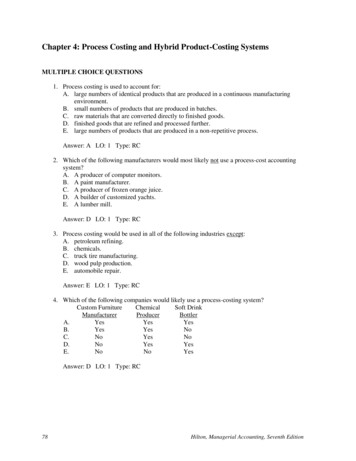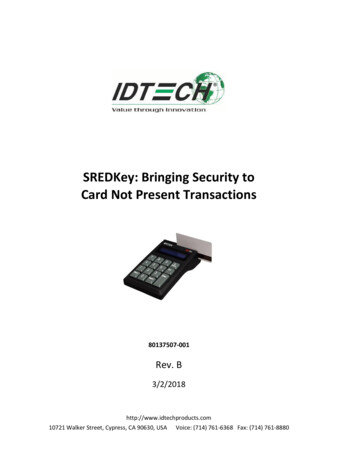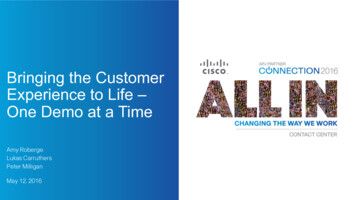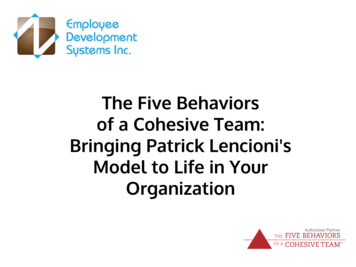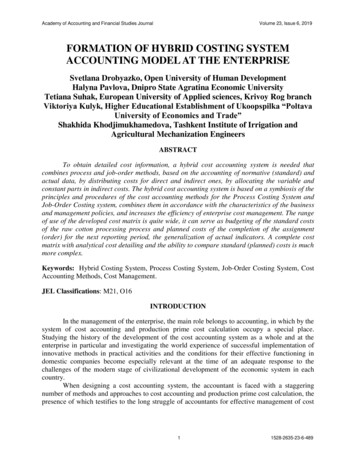
Transcription
Bringing JobCosting tothe Field.Where it Belongs
BRINGING JOB COSTING TO THE FIELD.WHERE IT BELONGS2Table of ContentsI.What Financials Mean to Accountants vs Project Managers5II.The Field/Office Divide7III. Real-Time Reporting9IV. The Impact of Real-Time ReportingProactive vs reactive budgetingEliminate time-consuming job costing reportsRemove dual entryImprove company insights11V. Leverage Financial Data to Boost Your Bottom Line13SHARE
BRINGING JOB COSTING TO THE FIELD.WHERE IT BELONGS3SOFTWARE-AS-A-SERVICE (SAAS) JOB COSTING SYSTEMS AREAN INEVITABLE DEVELOPMENT AS CONSTRUCTION BUSINESSESOVERCOME THE DISCONNECTIONS INVOLVED WITH RUNNINGMULTIPLE, GEOGRAPHICALLY DISPERSED PROJECTS.In construction, we are often designing and constructing made-to-orderassets, so there is immediately less certainty. We may be dealing with multipleprojects for different people, with different schedules, and run by differentproject managers.Each will be in a different location, with different site footprints, different groundconditions, different access routes, etc. And, partly influenced by their locations,we are often dealing with different suppliers––we might select local designers,subcontractors, plant, materials, and product suppliers based on their proximityto the site.Field financial management will therefore need to be adapted for eachproject to reflect its nature, its timespan, location, supply chain, and personnel.And timely, consistent, and reliable reporting to the finance director will beeven more of a challenge when a company is undertaking a diverse range ofprojects simultaneously.When it comes to construction financial management, it may feel like we haveto start with a clean (spread)sheet of paper. But, of course, the industry hasSHARE
BRINGING JOB COSTING TO THE FIELD.WHERE IT BELONGS4been able to develop standardized approaches to costcontrol and financial reporting.While reflecting commercial accounting norms, ourmost widely used accounting or enterprise resourceplanning (ERP) tools are often construction-specific:they reflect the transient, complex and project-basednature of our work, the diversity of suppliers that wework with, and the inevitability of change.Bodies such as the US’s Construction StandardsInstitute (CSI) have created industry standardclassification systems so that we can break work downand use consistent terminology and codes acrossbudgets, estimates, contracts, change orders, invoices,etc. As a result, project managers can get a verygranular view on a line item by line item basis at costcode / cost category levels of detail.ERPSHARE
I. What Financials Meanto Accountants vsProject Managers
BRINGING JOB COSTING TO THE FIELD.WHERE IT BELONGSACCOUNTANTS WORK FROM THE OFFICESUMMARIZING FINANCIAL TRANSACTIONS––THE OPERATIVE WORD BEING SUMMARIZE.They’re meant to record and analyze financialtransactions after they occur. They dwell in a realmof invoices, expense reports, payroll, quarterly profitand loss statements, audits, trend analysis, and otherforecasting. Their biggest challenges lie in maintainingcontrol over data, achieving full visibility into finances,getting access to accurate information, double entry,and standardizing input for trendable insights.6minute picture of where the project stands against theoverall estimated project budget. Without it, projectmanagers aren’t able to spot issues and take correctiveaction before costs eat into profit margins. Their dayto day involves managing the coordination of theschedule and budget, making daily financial decisionswith financial repercussions, monthly job cost reports,and owner relationships. Their biggest challenge isgetting real-time updates in the field while constantlyon the move.Job costing, on the other hand, is a daily task done inreal time on the jobsite. Your boots on the ground fieldteams need mobile options for an accurate minute-by-SHARE
II. The Field/Office Divide
BRINGING JOB COSTING TO THE FIELD.WHERE IT BELONGS8For a company finance director, getting a pan-project view ofthe financial position can be more difficult.Traditional construction accounting/ERP applicationsare often back-office systems, installed on-premise,with little to no direct connection to field operations.As a result, project reporting from individual projectswill often involve monthly submissions of spreadsheetssummarizing changes and resulting impacts on theprojects’ budgets––occasionally, major cost changesand/or delays may not be notified until 3-4 weeks afterthey occurred.In much the same way that mobile and web-basedconstruction collaboration platforms have helpedcreate single shared versions of the truth acrossour projects, SaaS job costing applications can helpclose, even eliminate, the field-to-back-office divideand the financial management gaps––both geographicand time-related––between individual sites andthe boardroom.Such retrospective reporting, repeated across multipleprojects, can mean major impacts on the business’scash flow and profit/loss may not be visible for someweeks, particularly if historic reports also need to beaggregated and re-entered (maybe with a little humanerror!) to give an accurate, consolidated view of thecompany’s position at a board meeting.SHARE
III. Real-Time Reporting
BRINGING JOB COSTING TO THE FIELD.WHERE IT BELONGSBY CAPTURING DAILY COST CHANGES IN ASAAS PLATFORM INSTEAD OF SPREADSHEETSAND EMAILS, PROJECT MANAGERS CANQUICKLY GENERATE UP-TO-THE-MINUTEDASHBOARD VIEWS OF THE FINANCIALHEALTH OF THEIR JOBS.They can monitor the impacts of change againstthe budget and program (maybe also allowingaction to be taken to improve the forecast position),and, importantly, share that information securelyand in real-time with their finance director and otherauthorized colleagues.10can also “drill down” to examine the underlying detailsfrom the field), eliminates the data-entry and reportingtime-lags and errors, provides better forecastsacross all projects, and provides a basis for confidentdecision-making with respect to any “problem” jobs.And SaaS job costing tools can also be used to makemore strategic decisions––for example, the aggregateddata can yield business intelligence about thecustomers or the supply chain partners who contributeto our most profitable jobs (and the ones who don’t).At the head office, we are no longer summarizingpast performance. Instead, real-time reporting acrossmultiple jobs gives instant visibility of current projectperformance. It identifies unexpected variances (usersSHARE
IV. The Impact ofReal-Time Reporting
BRINGING JOB COSTING TO THE FIELD.WHERE IT BELONGS12PROACTIVE VS REACTIVE BUDGETING.REMOVE DUAL ENTRYBy bringing job costing to the field and out of theoffice, project managers can account for potentialcosts as they occur. No more hassle of going to andfrom the office to enter in all of those changes at theend of the day. When project managers no longer haveto wait on accounting for up-to-date financial data,they have the tools in hand to manage a dynamic,living budget.Empowering field teams to input financial data inreal-time only makes an accountant’s job easier. Byintegrating the field team’s job costing solution withthe office’s accounting software, there is no need fordouble entry and the risks of inaccurate data input thatgo along with it. Instead of spending time inputtingdata, you can focus on balancing budgets.ELIMINATE TIME-CONSUMING JOBCOSTING REPORTSWith a proper field financials solution that offerscustom reports and a configurable budget, projectmanagers can generate the weekly or monthly reportsthey need with a click of a button, and provide keystakeholders with the insights they need to makeinformed business decisions.IMPROVE COMPANY INSIGHTSWith a single solution that enables project managersto track costs more efficiently and generate jobcost reports more quickly, accountants can have theconfidence in data from the field to make reliable, datadriven forecasts that their CFO needs.SHARE
V. Leverage Financial Datato Boost Your Bottom Line
BRINGING JOB COSTING TO THE FIELD.WHERE IT BELONGS14Tracking labor, materials, equipment, and all the other costsassociated with a build results in a wealth of data.Data can be used to track the company’s capabilitiesand how quickly staff responds to change orders andother issues impacting budgets.This level of knowledge allows project managers andsuperintendents to make faster decisions. Becauseinformation is always current, it also gives projectmanagers the autonomy to make important decisions,which drive efficiency and accuracy with each project.The efficiencies and accuracies that technologyprovides frees project managers from the extensiveand time-consuming job costing tasks. Technologyimproves overall project management and promotes acompany culture of accuracy and informed decisionmaking. It empowers project managers to be decisionmakers and helps head off any issues on the jobsite,because they can better carry out their roles.With a fully integrated construction operatingsystem––where financial software like job costingand accounting share data––you’ll get a clearerpicture of how your company functions in real-time(providing you with live insights into how yourmargins are behaving).You’ll be able to spot important trends like inputincreases, how frequently you’re losing out toavoidable change orders, how you’re performing indifferent markets, and even how one subcontractor’sproductivity compares to that of another.Today’s the day to take that step forward. Review yourcompany’s data assets and make sure your softwaresolutions do the heavy lifting and interpret datafor you. In this data-driven world, your data is yourcurrency. Can you really afford to ignore it?With the right technology in place, companies canleverage huge data sets to automate financial recordkeeping and generate intelligent, actionable insights.SHARE
BRINGING JOB COSTING TO THE FIELD.WHERE IT BELONGSPRODUCED BYProcore Technologies, Inc.Procore Technologies, Inc., the world’s most widelyused construction management software, helpsconstruction firms simplify their processes with aneasy-to-use, mobile-enabled platform providingunlimited user licenses and renowned customersupport. Understanding the industry’s uniqueneeds, Procore’s user-centric product developmentensures more efficient project, quality, andfinancial management, helping companies increasecollaboration, build times, and profit.For more information or a free demonstration visitwww.procore.com.Talk with an Expert15Visit The Jobsite Procore’s Hub for Original ContentWatch Procore TV Procore’s Official YouTube ChannelMore Resources Free eBooks & DownloadsIf you have any questions, please give us a call at1.866.477.6267 or email us: sales@procore.comSHARE
most widely used accounting or enterprise resource planning (ERP) tools are often construction-specific: they reflect the transient, complex and project-based nature of our work, the diversity o
